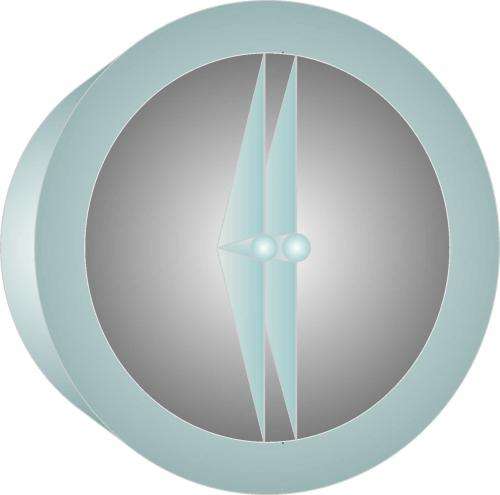New dynamic dual-core optical fiber enhances data routes on information superhighway

Optical fibers—the backbone of the Internet–carry movies, messages, and music at the speed of light. But for all their efficiency, these ultrathin strands of pristine glass must connect to sluggish signal switches, routers, and buffers in order to transmit data. Hoping to do away with these information speed bumps, researchers have developed a new, dual-core optical fiber that can perform the same functions just by applying a miniscule amount of mechanical pressure.
These new nanomechanical fibers, which have their light-carrying cores suspended less than 1 micrometer apart from each other, could greatly enhance data processing and also serve as sensors in electronic devices. The researchers describe their new fiber and its applications today in the Optical Society's (OSA) open-access journal Optics Express.
"Nanomechanical optical fibers do not just transmit light like previous optical fibers," says Wei H. Loh, deputy director of the EPSRC Centre for Innovative Manufacturing in Photonics and researcher at the Optoelectronics Research Centre, both at the University of Southampton, U.K. "Their internal core structure is designed to be dynamic and capable of precise mechanical motion. This mechanical motion, created by applying a tiny bit of pressure, can harness some of the fundamental properties of light to give the fiber new functions and capabilities."
This innovation was achieved by fabricating fibers with two cores—the pathways that carry data in the form of light—that are close enough to each other to be optically coupled, a property of light by which a photon's influence can extend beyond the fiber's core, even though the light itself remains inside. By shifting the position of one of the cores by just a few nanometers, the researchers changed how strongly the light responded to this coupling effect.

If the coupling effect is strong enough, the light immediately jumps from one fiber to the other. "Think of having a train traveling down a two-track tunnel and jumping the tracks and continuing along its way at the same speed," explains Loh. The flexible suspension system of the fiber easily responds to the slightest bit of pressure, bringing the two cores closer together or moving them apart, thereby controlling when and how the signals hop from one core to the other, reproducing, for the first time, the function of an optical switch inside the actual fiber.
This same capability may also enable optical buffering, which, according to the researchers, has been very hard to achieve. "With our nanomechanical fiber structure, we can control the propagation time of light through the fiber by moving the two cores closer together, thereby delaying, or buffering, the data as light," says Loh. Buffers are essential when multiple data streams arrive at a router at the same time; they delay one stream so another can travel freely.
To create the new fibers, the researchers heated and stretched a specially shaped tube of optical glass with a hollow center containing two cores suspended from the inside wall [see image 1]. The fibers maintain this original structure as they are drawn and stretched to the desired thickness.
According to the researchers, this is the first time that nanomechanical dual-core fibers have been directly fabricated. Other types of multicore fibers have been fabricated previously, but their cores are encased in glass and mechanically locked. This previous design meant that routing, switching, or buffering data involved taking the light out of the optical fiber for processing in the electronic domain before reinsertion back into the fiber, which is cumbersome and costly. "An implication of our work is that we would integrate more of these functions within the fiber backbone," says Loh, "through the introduction of MEMS (microelectromechanical systems) functionality in the fibers."
Since the new process utilizes traditional fiber optic manufacturing techniques, it's possible to create dual-core fibers that are hundreds of meters to several kilometers long, which is essential for telecommunications.
Loh and his colleagues also expect this introduction of MEMS functionality into the optical fiber to have implications in other fields, such as sensing. "Nanomechanical fibers could one day take the place of silicon-based MEMS chips, which are used in automobile sensors, video game controllers, projection displays, and other every-day applications," observes Loh. Because the fibers are so sensitive to pressure and can be readily drawn to very long lengths, they also could be integrated into bridges, dams, and other buildings to signal subtle changes that could indicate structural damage.
The next step of their research is to test the fibers at longer lengths and to enhance the precision with which they perform switching and other functions. The researchers hope that nanomechanical fibers could begin to enhance telecommunications and industrial systems within the next three to five years.
More information: "Nanomechanical optical fiber," Optics Express, Vol. 20, Issue 28, pp. 29386-29394 (2012) link: www.opticsinfobase.org/oe/abst … m?uri=oe-20-28-29386
The team will also present on this work at the Optical Fiber Communication Conference and Exposition/National Fiber Optics Engineers Conference (OFC/NFOEC), March 17-21, 2013 in Anaheim, Calif.
Journal information: Optics Express
Provided by Optical Society of America





















